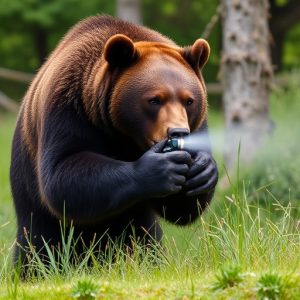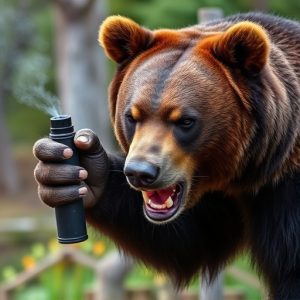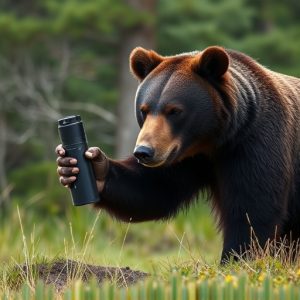Surviving Wilderness Encounters: Bear Defense Beyond Spray Ingredient Expiry
Grizzly bears' powerful senses necessitate understanding bear spray's effectiveness as a d…….
Grizzly bears' powerful senses necessitate understanding bear spray's effectiveness as a deterrent. Bear spray, containing capsaicin and propellants, has a 2-3 year lifespan and varies in potency by manufacturer. To maximize safety in bear country, combine bear spray with noise-making devices, proper food storage, awareness, and robust shelter to deter encounters without relying solely on bear spray's expiration date and ingredient stability.
In the vast wilderness, encountering a charging grizzly bear is a terrifying prospect. Understanding their behavior and harnessing effective defense mechanisms are crucial for survival. This article equips readers with essential knowledge about grizzly bears’ keen sense of smell, the science behind bear spray, including its ingredients, efficacy, and expiry date considerations, and alternative safety tips beyond just bear spray. By delving into these strategies, adventurers can navigate potential encounters with increased confidence and preparedness.
- Understanding Grizzly Bear Behavior and Their Sense of Smell
- Deciphering Bear Spray: Ingredients, Efficacy, and Expiry Date Considerations
- Wilderness Safety Tips: Alternative Defense Mechanisms Beyond Bear Spray
Understanding Grizzly Bear Behavior and Their Sense of Smell
Grizzly bears are powerful and unpredictable animals, and understanding their behavior is crucial for safety in wilderness areas. These bears have an exceptional sense of smell, which they use to locate food sources and navigate their environment. They can detect odors from long distances, sometimes up to a mile away, making it essential to minimize any scent that could attract them. This heightened sense of smell is linked to their excellent memory, allowing them to remember specific smells for extended periods.
When encountering a grizzly bear, one of the commonly recommended deterrents is bear spray, but it’s important to note that these products have expiration dates and specific ingredients. Bear spray works by creating a barrier of capsaicin-based chemicals when sprayed towards the bear, temporarily blinding and disorienting them. However, factors like temperature, storage conditions, and exposure to sunlight can affect its effectiveness over time. Users should check the label for expiration dates and ensure they understand how to properly apply the spray to maximize its potential as a defense mechanism against charging grizzlies.
Deciphering Bear Spray: Ingredients, Efficacy, and Expiry Date Considerations
Bear spray, a popular defense mechanism against aggressive bears, is a specialized pepper spray designed for outdoor use. When faced with a charging grizzly, having this spray on hand can be a lifesaver. However, understanding its components and shelf life is crucial before relying on it in an emergency.
The primary active ingredient in bear spray is capsaicin, derived from chili peppers. This substance irritates the bear’s eyes, nose, and respiratory system, causing them to back off temporarily. Other ingredients include propellants like butane or CO2, which propel the spray at high velocity. Some formulations also contain additives for better performance in various weather conditions. While effective against grizzly bears, the spray’s potency can vary based on the manufacturer and ingredient quality. Moreover, it is essential to check the expiry date, as bear spray typically has a limited shelf life of 2-3 years due to potential degradation of active ingredients over time. Regularly inspecting and replacing expired spray is critical for ensuring its effectiveness in an emergency encounter with these formidable predators.
Wilderness Safety Tips: Alternative Defense Mechanisms Beyond Bear Spray
When venturing into bear country, it’s crucial to have a comprehensive safety strategy beyond just carrying bear spray. While bear spray is an essential tool, understanding alternative defense mechanisms can significantly enhance your wilderness experience. One effective method is to make noise to deter bears; loud voices or musical instruments can startle them and encourage them to retreat.
Additionally, carrying and knowing how to use a bear whistle is valuable. These whistles are designed to emit high-pitched sounds that bears find unpleasant, allowing you to signal for help or scare off an approaching bear without directly confronting it. Remember, prevention is key; proper food storage and awareness of your surroundings can greatly reduce the risk of encounters. Keep your food sealed and secured, avoid wandering alone, and make sure your shelter is robust—these measures will significantly lower the likelihood of a bear interaction.
In conclusion, understanding grizzly bear behavior and utilizing effective defense mechanisms like bear spray (while considering its ingredients, efficacy, and expiry date) are crucial for navigating wilderness safely. Beyond bear spray, there are alternative strategies to enhance your safety, such as making noise to deter bears and properly storing food to avoid attracting them. By combining knowledge with practical tips, you can significantly reduce risks when venturing into bear country.


